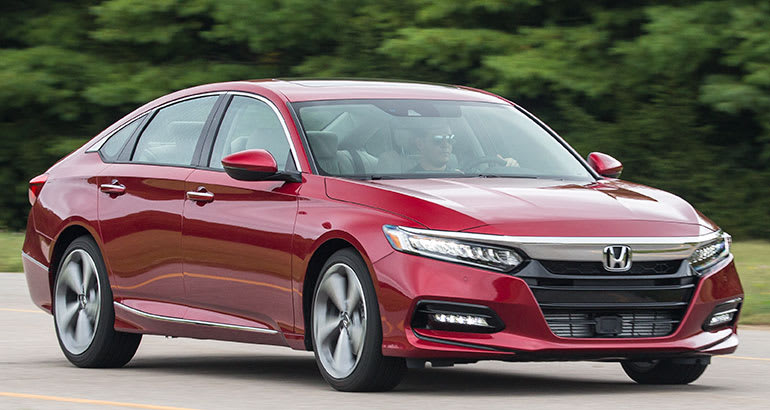Consumer Reports has no financial relationship with advertisers on this site.

Radical revisions are rare in the popular midsized sedan segment. Yet the 2018 Honda Accord brings wholesale changes—from curvy, coupe-inspired styling to turbocharged engines—in what is a dramatic makeover for a perennial segment leader.
Consumer Reports applauds Honda for making advanced safety features, including forward-collision warning and automatic emergency braking, standard equipment across all Accord trims.
CR rented a top-shelf Touring model from Honda to gather our initial impressions. Clearly, Honda has evolved the traditionally conservative Accord, and the result appears to be as satisfying as ever. The new version starts arriving at dealers in mid-October.
One of the biggest changes to the Accord’s new mixture is the switch to turbocharged four-cylinder engines (a 1.5-liter version and a 2.0-liter version) and giving up on any V6 version.
We were impressed with the slickness of the 2.0-liter turbo, 10-speed automatic drivetrain from the moment we stepped on the accelerator pedal. Although you might miss the sound of the V6, this punchy turbo-four delivers strong, smooth power, yet stays refined, even when the engine is really pushed. The automatic transmission is smooth and responsive, and it delivers almost imperceptible shifts.
The 2.0-liter turbo-four (adapted from the Civic Type R) that puts out 252 hp replaces the lively and beloved 3.5-liter V6. This new engine is linked to an all-new 10-speed automatic transmission. Either engine type is available with a six-speed manual (a rarity these days) in the Sport trim. A four-cylinder hybrid will join the lineup in early 2018.
The smaller, 1.5-liter base engine produces 192 hp and is mated to a continuously variable transmission. We’ve seen this engine before, in the Civic and the CR-V. This is the most powerful base engine ever in an Accord. The Environmental Protection Agency estimates the Accord 1.5T at 33 mpg combined with the CVT, a 3-mpg improvement over the old engine.
This latest Accord skews to the athletic side among family sedans, and the steering’s weighty feel contributes to a solid, substantial handling experience. The Touring trim’s ride irons out bumpy roads, but considering it comes standard with two-mode adaptive suspension, we expected it to be a little more tied down. The standard 19-inch wheels on the Touring certainly didn’t help with its ride quality. Most Accords come with 17-inch wheels. A hushed cabin hasn’t been a Honda trademark, but we found that this one does a nice job muting the road, wind, and engine noise.
A prominent single-screen infotainment system replaces the dual-screen setup that infuriated us on higher-trim models of the outgoing Accord. It’s more user-friendly than before, featuring vivid, colorful graphics and the ability to rearrange icons—but there is still a learning curve for drivers. We appreciate getting knobs for audio volume and tuning. The new digital and analog instrument cluster reinforces the high-tech nature of the new car.
Most controls work well throughout the car, but we’re not fans of the push-button shifter in models with the 2.0-liter engines. It’s the same setup we’ve disliked in other Honda and Acura products. It’s unintuitive, and we’ve found it to be a particular nuisance when parking or trying to make three-point turns. Luckily, the 1.5-liter/CVT combo—the car most consumers will buy—comes with a traditional gear selector.
The new Accord got lower and wider, so getting in and out requires more ducking. There is plenty of headroom and elbow room up front, plus wide and comfortable seats including four-way lumbar adjustment on the Touring version. Slide into the rear seat and you’re greeted with abundant legroom, though headroom is a bit limited, which could make it feel confining for taller folks. Honda says the cargo area is slightly larger than in the outgoing model.
The standard Honda Sensing suite of advanced safety systems includes forward-collision warning, automatic emergency braking, lane-keeping assist, adaptive cruise control, and auto high beams. Models with the manual transmission have automatic emergency braking, which some other automakers don’t provide. Unfortunately, blind-spot warning and rear cross-traffic alert are not part of the standard package, though they are available.
Pricing begins at $23,570 for the 1.5T. If you want a manual transmission, you need to step up to the Sport at $25,780. The Accord with the more powerful 2.0-liter engine starts at $30,310, reaching $35,800 for the top Touring trim.
We’ll be buying a 2018 Honda Accord of our own when available this month. The 2.0L reaches market in November, with the hybrid following in early 2018. Make sure you check back to see how the new model stacks up against competitors after we put it through our full test regimen.
Hi! I am a robot. I just upvoted you! I found similar content that readers might be interested in:
https://www.consumerreports.org/sedans/2018-honda-accord-first-drive-review/
Downvoting a post can decrease pending rewards and make it less visible. Common reasons:
Submit